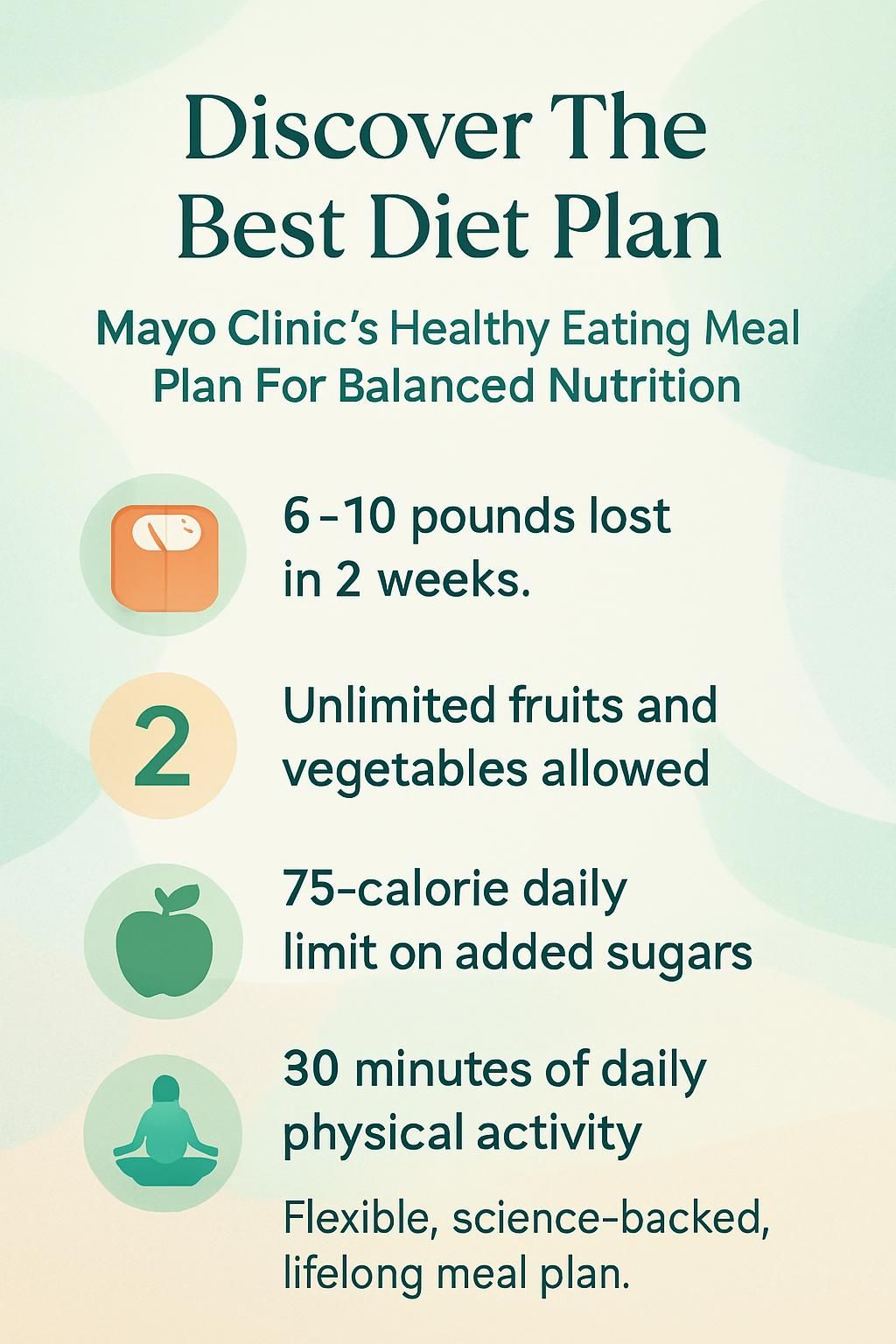Discover The Best Diet Plan: Mayo Clinic’s Healthy Eating Meal Plan For Balanced Nutrition
Our Nutrition Assistant AI Suite will transform your body. You will lose fat, get toned, and build muscle. Gain confidence and optimal health.
You see lots of diet advice, and it can feel hard to sort out. The Mayo Clinic Diet offers a long-term healthy eating plan that supports a healthy weight and lower disease risk. It focuses on balanced nutrition and steady, realistic progress.
This guide explains the best diet plan basics in plain language. You will learn core habits, smart food choices, and easy meal ideas built on Mayo Clinic guidance. Small shifts add up fast. You can start today and see clear benefits.
Key Takeaways
- The Mayo Clinic Diet uses two phases, Lose It! then Live It!, to support safe weight loss. Many people lose 6 to 10 pounds in the first 2 weeks, then about 1 to 2 pounds per week afterward.
- The plan highlights generous fruits and vegetables, whole grains, lean proteins such as fish or beans, healthy fats like olive oil, and portion control guided by the Healthy Weight Pyramid.
- Added sugars are limited to a 75-calorie treat each day. You also reduce saturated fat intake to support heart health.
- Tracking meals with a journal or app and getting at least 30 minutes of physical activity daily help improve results over time, according to Mayo Clinic guidance.
- The approach is flexible and evidence-based. You keep all food groups, build lasting habits, and avoid extreme rules.

What is the Mayo Clinic Healthy Eating Meal Plan?

The Mayo Clinic Healthy Eating Meal Plan is a practical, research-informed pattern for weight management and health. You build meals from major food groups, especially fruits, vegetables, whole grains, lean proteins, and healthy fats. This balanced diet supports steady energy and fewer cravings.
What is the Mayo Clinic Diet?
The Mayo Clinic Diet is a clear eating plan that helps you lose weight safely. You start with the Lose It! phase for 2 weeks. During this time, you practice five healthy habits, stop five unhealthy habits, and add five daily actions that reinforce progress.
Next, you move to the Live It! phase, which you follow for life. Weight loss usually continues at 1 to 2 pounds per week as you strengthen habits and build a routine. You track meals and weight, choose simple recipes like overnight oats or roast chicken, and enjoy one 75-calorie sweet per day without derailing your plan.
How does it focus on long-term lifestyle changes?
The diet uses behavior strategies to turn new choices into regular habits. You replace routines like frequent added sugars with nutrient-dense foods, for example more vegetables, whole grains, fish, or skinless poultry. Low-fat dairy can help you meet calcium and protein needs without much saturated fat.
These steps support healthy weight, better blood pressure, and improved heart health. Planning meals and tracking intake help you spot patterns, such as high-sodium foods, before they affect your numbers. Step by step, healthy living becomes your new normal.
The Core Principles of the Mayo Clinic Diet
The Mayo Clinic Diet centers on balanced nutrition and repeatable habits. These principles make daily choices easier and more consistent.
How does the diet emphasize balanced nutrition?
The Healthy Weight Pyramid guides what and how much to eat. Fruits and vegetables fill the largest base because they add volume, fiber, and key vitamins with fewer calories.
You include moderate amounts of whole grains for steady energy, plus lean proteins like beans, eggs, or fish. Low-fat dairy adds calcium and protein. Small amounts of fats and sweets sit at the top, which reminds you to limit saturated fat and added sugar.
Choosing foods from every level of the pyramid is key to a healthy diet.
This balance supports portion control and helps lower the risk of heart disease and type 2 diabetes.
What is the Mayo Clinic Healthy Weight Pyramid?
This pyramid is a simple, visual tool. At the base are fruits, vegetables, and daily physical activity. Higher levels include whole grains, lean proteins, and low-fat dairy, which you eat in measured portions.
Fats and sweets are at the top, which signals smaller servings. That structure teaches portion control without strict calorie counting. You get more servings from the lower layers, and fewer from the top.
Using the pyramid makes shopping and meal building straightforward. It keeps your focus on nutrient-dense foods most of the time.
How does the diet promote portion control and mindful eating?
You do not need to count every calorie. Instead, you follow the pyramid for portions. Fruits and vegetables are free or very flexible, making it easier to feel full while limiting high-calorie foods that contain added sugars, sodium, or saturated fat.
You also track what you eat in a journal or app. Writing down meals helps you notice triggers, large portions, or mindless snacking. These mindful steps support weight loss and better health without rigid rules.
What are the Benefits of the Mayo Clinic Diet?
The plan encourages habits you can maintain for years. It blends weight loss with health benefits that matter in daily life.
How does it support sustainable weight loss?
You build meals with fruits, vegetables, whole grains, and healthy fats. Simple tools, like a food log and weight tracker, help you see progress. In the Lose It! phase, many people lose 6 to 10 pounds in 2 weeks by trimming added sugars and using portions wisely.
In the Live It! phase, weight loss usually continues at 1 to 2 pounds per week with regular activity. The plan avoids extreme rules or very low-calorie menus, which can be hard to maintain. It favors steady changes that last.
How does it improve overall health and energy?
High-fiber foods like fruits, vegetables, and whole grains can stabilize blood sugar and reduce energy dips. These foods also support digestion and help you feel satisfied.
Daily activity, even brisk walking, boosts mood and stamina. Eating fewer highly processed foods and added sugars can reduce afternoon crashes and make focus easier during work or school.
How does it reduce the risk of chronic diseases?
Eating more plants is linked with lower risk for several conditions, including heart disease, high blood pressure, and type 2 diabetes. Whole grains add fiber that supports heart health and steadier blood sugar.
Cutting back on added sugars and saturated fat helps improve cholesterol and weight control. Combining this plan with regular activity strengthens your protection over time.
How Does the Mayo Clinic Diet Work?
The diet uses two clear phases so you can build momentum, then keep it.
What happens during the Lose It! phase?
For two weeks, you focus on specific habits. You add five healthy behaviors, drop five less helpful ones, and complete five bonus actions each day. You eat plenty of fruits and vegetables to fill up with fewer calories, and you limit sweets to a 75-calorie treat daily.
Many people lose 6 to 10 pounds in this phase as they swap sugary drinks for water, plan meals, and control portions. These quick wins provide motivation to continue.
What is involved in the Live It! phase?
Live It! is lifelong. You maintain your new habits, fine-tune portions, and keep moving every day. Expect a steady loss of about 1 to 2 pounds per week while building skills you can sustain.
Track food, activity, and weight with simple tools. If you have high cholesterol or need a low-sodium approach, a registered dietitian can help you customize the plan. Focus on fruits, vegetables, whole grains, and lean proteins, then add healthy fats in small amounts.
Which Healthy Foods Should You Focus On?
Choosing the right foods makes the plan easier to follow and easier to enjoy.
Why are fruits and vegetables important?
Fruits and vegetables sit at the base of the pyramid because they are high in fiber and water. Fiber supports digestion and helps control hunger. These foods bring vitamins like A and C, plus minerals such as potassium and folate.
Aim for at least five servings per day. Colorful produce adds variety, flavor, and crunch with fewer calories than most snacks.
What role do whole grains play?
Whole grains, like brown rice, oatmeal, and whole-wheat pasta, supply fiber and slow-digesting carbs. They help steady blood sugar, keep you full longer, and support digestive health.
Replacing refined grains with whole grains is a simple upgrade. Many people find a bowl of oatmeal or quinoa at breakfast carries them to lunch without cravings.
Which lean proteins and healthy fats are recommended?
Lean proteins help maintain muscle and curb hunger. Choose skinless chicken or turkey, fish such as salmon or cod, beans, lentils, or tofu. If you eat red meat, pick lean cuts and serve smaller portions.
Use healthy fats in small amounts. Nuts and seeds add crunch and vitamin E, while olive oil gives flavor with mostly unsaturated fat. These foods are calorie dense, so a little goes a long way.
Why limit added sugars and saturated fats?
High intakes of added sugar and saturated fat are linked to weight gain and higher heart disease risk. The plan caps sweets at 75 calories per day, which helps you enjoy dessert without overdoing it.
Limiting these nutrients leaves more room for foods that support health, like whole grains and produce. Many people notice better energy when they trade soda and candy for water, fruit, or a handful of nuts.
What Does a Typical Mayo Clinic Meal Plan Look Like?
A typical day features all food groups in balanced portions. Meals are simple, colorful, and satisfying.
What are some sample breakfast options?
Breakfast sets the tone for the day. Aim for fiber, protein, and produce so you start full and focused.
- Overnight oats with chia seeds, blueberries, and unsweetened almond milk for sustained energy and fiber.
- Whole-grain toast with avocado and tomato, plus a side of fresh fruit.
- Greek yogurt with mixed berries and walnuts for protein and healthy fats.
- Spinach, banana, and frozen berries blended with flaxseed and fortified soy milk.
- Scrambled eggs in olive oil with sautéed bell peppers or leafy greens.
- Hot oatmeal with diced apples or pears and a pinch of cinnamon.
- Cottage cheese with sliced peaches or pineapple, served with whole-grain crackers.
- Warm quinoa porridge with chopped dried figs and pumpkin seeds for plant protein.
- Thin layer of nut butter on a whole-wheat English muffin topped with banana slices.
Pick one option and rotate across the week. This makes planning easy and reduces morning stress.
What are some lunch ideas to try?
Lunch keeps your afternoon steady. Choose a lean protein, add produce, and include a whole grain when possible.
- White bean soup with a slice of whole-wheat bread and steamed vegetables.
- Turkey sandwich on whole-grain bread with lettuce, tomato, and avocado. Use mustard instead of mayonnaise.
- Quinoa salad with cherry tomatoes, cucumbers, chickpeas, olive oil, and lemon juice.
- Grilled chicken over mixed greens with sliced almonds, orange segments, and a light vinaigrette.
- Vegetable stir-fry with broccoli, bell peppers, carrots, and tofu, served over brown rice.
- Baked salmon with steamed green beans and wild rice for omega-3 fats and fiber.
- Greek yogurt with walnuts, berries, and a drizzle of honey for a lighter meal.
- Limit meals high in added sugars or salt to reduce negative health effects such as high blood pressure or increased risk of chronic diseases like Alzheimer’s disease[1].
- Drink water or unsweetened tea instead of sugary drinks to lower calories and support digestion.
Planning lunches with lean proteins and fiber-rich sides can tame cravings until dinner.
[1] Mayo Foundation for Medical Education and Research (MFMER). Mayo Clinic Diet: A weight-loss program for life [Internet]. 2024 Jun [cited 2024 Jun 21]. Available from: https://www.mayoclinic.org/healthy-lifestyle/nutrition-and-healthy-eating/in-depth/mayo-clinic-diet/art-20045460
What dinners and snacks fit the plan?
Dinner should feel satisfying without being heavy. Snacks fill gaps and protect against late-night overeating.
- Roast chicken with bell peppers for lean protein and antioxidants with less sodium than many packaged meals.
- Grilled salmon or shrimp with leafy greens for omega-3 fats, vitamin K, and fiber.
- Stir-fried tofu with cashews and brown rice for a plant-forward dinner with less saturated fat.
- Whole-grain pasta tossed with tomatoes, spinach, and olive oil for steady energy.
- Banana as a simple snack with potassium that supports normal muscle and nerve function.
- A small handful of unsalted nuts for healthy fats and lasting fullness.
- Carrot sticks or bell pepper strips with hummus to curb mid-afternoon cravings.
- Yogurt topped with sliced fruit that can fit into your 75-calorie sweet, depending on portion.
- Roasted chickpeas with mild spices for a crunchy, high-fiber snack.
- Water or herbal tea in the evening to stay hydrated without added sugars.
Mix and match based on your tastes. Keep portions in line with the pyramid, and you stay on track.
Why Choose the Mayo Clinic Diet Over Other Diet Plans?
This plan is built on research and flexible routines, not internet trends.
What makes the approach evidence-based?
Experts at Mayo Clinic developed the diet using nutrition science and behavior research. The pyramid reflects studies on balanced meals and portion control.
Habit tracking and activity goals are proven to help people make changes that last. You follow steps supported by clinical experience and published guidance, not guesswork.
How is the diet flexible and adaptable?
The plan adapts to your calorie needs, tastes, and culture. No food group is banned. You can choose fruits, vegetables, whole grains, lean proteins, and healthy fats you enjoy.
You can also have a 75-calorie treat each day. Many people find this flexibility reduces stress and makes long-term success more likely.
What Are Tips for Success on the Mayo Clinic Diet?
A few simple habits make the plan easier to follow and easier to maintain.
How can planning meals in advance help?
Planning ahead ensures you hit all parts of the pyramid. You can map fruits, vegetables, whole grains, lean protein, and healthy fats across the day.
It also helps you set portions before hunger hits and keeps sweets to the 75-calorie allowance. Planning reduces last-minute choices that often add extra salt or sugar.
Why is tracking progress important?
Using a food or exercise journal helps you see what is working. The plan includes a weight tracker and daily logs so you can watch trends and make small fixes early.
People who track meals tend to lose more weight and keep it off compared to those who do not track.[1] Awareness supports better choices, including limiting added sugars and watching sodium.
…
[1] Keeping a food diary doubled participants’ weight loss in one study published by Kaiser Permanente (2008).
How to incorporate regular physical activity?
Aim for at least 30 minutes of daily physical activity to support the diet. Walking, cycling, and swimming are great, low-impact options. The pyramid places activity at its base because it strengthens health and helps control weight.
Short walks after meals are a simple way to start. Regular movement supports energy, weight management, and healthy blood pressure.
What Are Potential Challenges and How Can You Overcome Them?
Change takes practice. A few strategies can smooth the bumps early on.
How to adjust to new eating habits?
Make small changes first. Increase fiber over two to three weeks to reduce digestive discomfort. Lean on fruits and vegetables to feel full without many calories.
Plan meals and keep a journal to reinforce new routines. If you have medical concerns, ask a clinician or dietitian for advice that fits your needs.
How to manage cravings and portion sizes?
Choose fiber-rich foods, drink water, and eat slowly. Pause before seconds to check your fullness. Use the pyramid as a portion guide at every meal.
Track your snacks so you can spot triggers. If you want dessert, select a 75-calorie treat and enjoy it mindfully.
Explore which foods you enjoy most within the plan. Satisfaction makes cravings easier to manage.
How Does the Mayo Clinic Diet Compare with Other Popular Diets?
Many diets promise fast results. This plan favors steady habits that hold up.
What are the differences from the Mediterranean Diet?
Both approaches value plants, whole grains, and healthy fats. The Mediterranean Diet centers olive oil and frequent fish. The Mayo Clinic Diet uses the pyramid to guide portions and allows you to choose your preferred healthy fats.
Research supports the Mediterranean pattern for long-term heart health. Mayo Clinic’s plan focuses on portion structure and behavior tools that fit many lifestyles.
How does it compare to the DASH Diet?
DASH was built to lower high blood pressure with strict sodium limits and set daily servings. The Mayo Clinic Diet is more flexible. You follow hunger cues and the pyramid instead of tracking exact servings for each category.
Both plans encourage fruits, vegetables, whole grains, and lean proteins. If detailed counting feels overwhelming, you may prefer the Mayo approach.
What are the benefits over low-carb and keto diets?
You keep all food groups on the Mayo Clinic Diet. Unlike keto, which sharply limits carbs, you include whole grains, fruit, and starchy vegetables in measured portions.
This balanced eating pattern often feels easier to sustain. Many people report steadier energy and fewer side effects compared with very low-carb plans.
Frequently Asked Questions About the Mayo Clinic Diet
Here are quick answers to common questions before you start.
Is the Mayo Clinic Diet suitable for everyone?
Most adults can follow the plan safely. If you have diabetes, digestive disorders, kidney disease, or other health conditions, talk with your healthcare provider first. You may need adjustments to fit medications or lab goals.
Pay attention to how your body responds and make changes with a clinician if needed.
How quickly can you expect results?
During Lose It!, many people drop 6 to 10 pounds in two weeks. After that, typical progress is about 1 to 2 pounds per week in Live It! if you stay consistent with food choices and activity.
These rates follow safe guidelines for sustainable weight loss.
Can this diet be tailored for specific health conditions?
Yes. The plan allows flexibility with fruits, vegetables, grains, and proteins. If you need tighter blood sugar control or lower sodium, a registered dietitian can personalize servings and timing to match your goals.
Always check with your healthcare provider before making changes tied to a medical condition.
Conclusion
The Mayo Clinic Diet offers a clear path to healthy eating, a healthy weight, and better daily energy. You build meals from all food groups, practice mindful portions using the pyramid, and keep one small sweet without guilt. Habit tracking and regular activity make progress measurable and repeatable.
Start with small steps. Plan a week of simple meals, walk most days, and log what you eat. This article is for education only and does not replace medical advice. For personal guidance, consult a healthcare professional or a registered dietitian.
With steady practice, this balanced diet can support long-term weight management and everyday well-being.
FAQs
1. What is the Mayo Clinic’s Healthy Eating Meal Plan and how does it support balanced nutrition?
The Mayo Clinic’s Healthy Eating Meal Plan is a structured guide that promotes eating fruits, vegetables, whole grains, lean proteins, and healthy fats in proper portions. This plan uses evidence-based guidelines to help people achieve balanced nutrition while reducing processed foods and added sugars. Studies show that following such meal plans can lower the risk of chronic diseases like heart disease and diabetes.
2. How does this diet plan compare with other popular diets for weight management?
Research shows that the Mayo Clinic’s approach focuses on long-term lifestyle changes rather than quick fixes or extreme restrictions. Unlike fad diets, this meal plan encourages steady weight loss through nutrient-dense foods and portion control. For example, a 2023 review found participants using similar structured plans lost an average of 1-2 pounds per week over six months compared to less sustainable results from restrictive diets.
3. Can I follow the Mayo Clinic’s meal plan if I have specific dietary needs or health conditions?
Yes; this meal plan offers flexibility for various preferences including vegetarian or gluten-free options as well as adjustments for medical conditions like hypertension or high cholesterol. Registered dietitians recommend tailoring food choices within these guidelines to meet individual health requirements while maintaining nutritional balance.
4. What are some practical steps to start using the Mayo Clinic’s Healthy Eating Meal Plan in daily life?
Begin by planning meals around fresh produce, whole grains such as brown rice or oats, lean meats like chicken breast or fish fillet, and unsaturated fats from sources like olive oil or nuts. Tracking servings helps maintain correct portions throughout each day which supports consistent progress toward health goals.
Summary: The Mayo Clinic’s Healthy Eating Meal Plan provides clear guidance based on scientific research for achieving balanced nutrition through real food choices tailored to personal needs; its flexible structure makes it suitable for most individuals seeking lasting wellness improvements.







